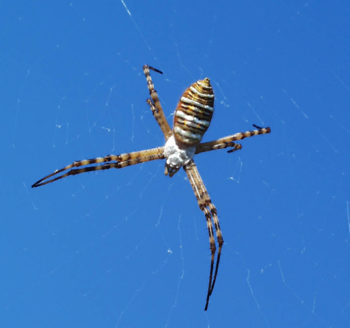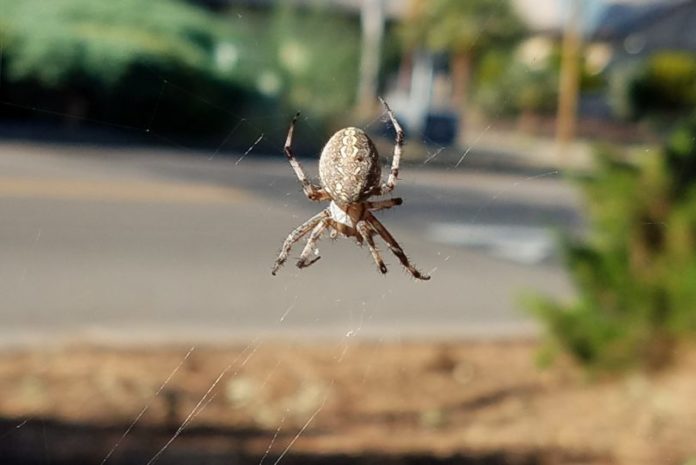By Gig Conaughton, County of San Diego Communications Office
They’re big. They’re scary looking. And they spin enormous, circular webs that can stretch between trees, from a tree to your house, or your house to your car. It’s orb weaver spider time again in San Diego County—and this year could yield a bumper crop.
Stumbling into an orb weaver web is an unmistakably creepy feeling. You could be hiking around the neighborhood, working in the yard, or walking out to the car.
Suddenly, you’re smacked right in the face, your hair, your arm or other exposed bit of skin by a large, sticky strand of web! Your spider-senses scream. You flail, stumble, try to peel the web away, and as passersby stare you’re doing what County supervising vector ecologist Chris Conlan calls “the crazy spider dance.”
Conlan, who has loved insects, spiders and critters since he was a kid, has been the County’s most visible “bug guy” for years as part of the County’s Vector Control Program.
Conlan said this week that county residents could see more orb weavers this year than they have in years. He said that’s because spiders—including orb weavers— have more little bugs to eat this year because we had a lot of rain, which created more vegetation and insects overall.
“So, you’re probably going to be running into a lot of spider webs very soon, if you haven’t already,” Conlan said.
Fortunately, Conlan said, orb weaver spiders are generally harmless to people. He said orb weaver spiders, like many spiders and insects, can bite, but they generally only do if they feel very threatened—even if they look scary.

Orb weaver’s webs are one of their most fascinating features. In fact, orb weaver spiders are not a singular species. They’re a family of spiders, classified by their web spinning, that come in various sizes and colors.
orb weaver spider
Orb weaver spiders are a family, rather than a species, and come in a variety of size and color.
Conlan said many spiders spin small, undistinctive strands of webs tucked into corners to catch prey. But orb weaver spiders spin large, circular, often beautiful webs, the classic kind Conlan said that we often see depicted in “kid’s books and children’s stories.” Orb weaver spider webs are often so big they seem to defy logic. They can literally stretch from one tree to another, or between large objects like houses and cars.
“It’s pretty amazing,” Conlan said. “They have a few ways of doing that. They can just walk down one tree and to another. Typically, they’ll spin a single strand of silk and a gust of wind will blow it to another branch or object. It will stick and the spider can now walk back and forth on that strand that’s now attached to the far-away object.”
Beauty aside, not many people are thrilled to run into an orb weaver spider web. The general reaction is revulsion, even for bug lovers like Conlan.
“Of course!” Conlan said. “I mean, you can’t help it, it’s only natural.”
So what can people do to dodge the orb weaver webs?
Conlan said this is the time of the year he risks looking “like a weirdo” around his house by walking everywhere with his hand out in front of him.
“You can either try to limit the number of objects you walk between that they can use as anchor points,” Conlan said, “or you just need to get used to walking either with a hand out in front of you, or a stick out in front of you, to clear them out of the way. You’re not hurting the spider by knocking the web out of the way.”
And it’s better than doing the crazy spider dance.
For more information about the County’s Vector Control Program, spiders and other vectors and critters, go to the County’s Department of Environmental Health’s website.
Related: insectsspider
Gig Conaughton is a communications specialist with the County of San Diego Communications Office


















